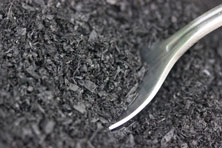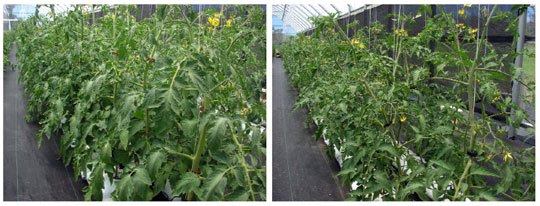1/28/2013
Black Makes Green
Josiah Hunt

Biochar is a term for which a single definition has been elusive. In its most simple essence, biochar is biomass that’s been charred, but is not intended for fuel. It’s intended for biological purposes, mostly as a way of enhancing characteristics of soils and potting media that are beneficial to plant growth.
Soil Organic Matter (SOM, humus) is generally thought of as partially decomposed organic matter that’s reached a point of relative stability. Oddly enough, there hadn’t previously been substantial differentiation between the portions of SOM that had been charred at some point and those that hadn’t. Charring of biomass occurs naturally during wildfires and is thus deposited in the soil. Once charred, the biomass becomes resistant to biological decay and can remain a part of the soil makeup for millennia. Our planet is literally covered in charred biomass or if you prefer, biochar. It’s normally found in small amounts with some notable exceptions, such as the famously fertile soils of the Midwest (Iowa’s soils have an average of more than 30% of the SOM as biochar) or the pockets of soil found in the Amazon Basin and referred to as Terra Preta. The Terra Preta soils appear to be the most outstanding example of humankind’s utilization of biochar. Hundreds of years ago, the native populations created pockets of rich, fertile soil that sustained large civilizations and lasted far beyond their demise. These soils lay buried beneath the forest and became the catalyst that helped modern science recognize the importance of charred biomass as a component of soil.

On the left, tomatoes at 5 weeks with a biochar/compost blend; right, tomatoes at 5 weeks without biochar.
Well-manufactured biochar can exhibit characteristics highly desirable for use as growing media. The charring process leaves behind only the carbon scaffolding. This can be a lightweight and extremely porous material, riddled with capillary tubes that served as transport for food and water within the living plant material. It can exhibit a very high surface area with a variable surface charge, lending it great ability to adsorb water and plant nutrients. Its porous nature and surface charge characteristics can directly translate into dramatic increases in water and nutrient efficiency when used with soil or potting media. Increases in total biomass, in yield, in growth rate and in overall plant health have all been observed where biochar has been applied, sometimes in orders of magnitude above the comparison.
Temperature matters—to the naked eye char is always some shade of black, but beyond that is a wide spectrum of possible characteristics that depend upon the temperature and process with which it was made. This can make the difference between a material that’s either harmful or beneficial to plant growth! The horticultural charcoals of the past (and even present) were not produced with the benefit of current knowledge and will typically not compare with modern biochar products.
The structure of the original biomass carries through fairly well into the biochar created. For example, biochar created from soft woods or grasses will end up feeling similar to perlite and vermiculite, respectively. Biochars produced from harder woods and nutshells will end up feeling more like cinder or even gravel (though with a much, much higher functional surface area).
Unlike most, I’ve worked almost exclusively with biochar application rates by volume and transferred this among both field and greenhouse research. I’ll most often start with biochar as 5 to 10% of the media. Over the years, this has proven to be a generic sweet spot, whether in the ground or in pots. Some notable exceptions are orchids—where 20% or more is often used—when hydroponics and rooting media is much the same, and certain other applications—like tomatoes, which seem to go nuts for biochar. The limit seems only set by pH and particle size distribution.
The greatest news about biochar in 2013 is that it’s finally available on a commercial scale. Soil Reef has thousands of tons of high-quality material set to hit the market this year at prices that were never achievable before. Whether you’re looking for truckloads or just a few bags, you can contact Soil Reef via the website at
www.SoilReef.com or by phone at (954) 309-8721.
GT
Josiah Hunt is the director of Hawaii Biochar Products LLC and a partner in The Biochar Company, based in Pennsylvania. He can be reached by email at josiah@hawaiibiochar.com.